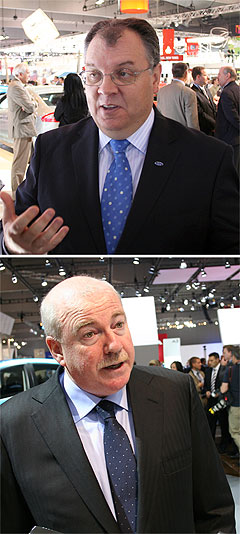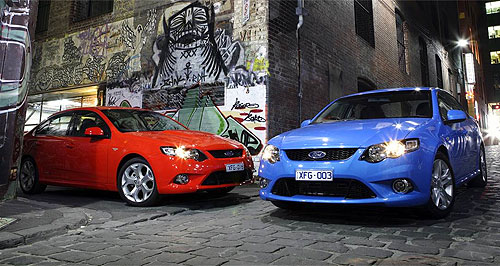Make / Model Search
News - FordFord predicts million marketOn the up: Ford has high hopes for Falcon sales this year. Australian new-vehicle market could return to one million mark this year, says Ford25 Mar 2010 FORD believes Australia’s new-vehicle market this year could return to the million mark it exceeded in 2007 and 2008, while sales of its locally built Falcon and Territory will increase by up to 20 per cent. Ford’s prediction of between 970,000 and one million sales for 2010, revealed by president Marin Burela in a conference call with media yesterday, is far more ambitious than the general industry consensus, which puts this year’s total industry figure at around the same level as 2009, when 937,328 new vehicles were sold. While the annualised running rate stands at 1.027 million vehicles after two boom sales months in January and February, industry analysts attribute the positive start to after-effects of the federal government’s 50 per cent business tax allowance in 2009 and point to a continuing private buyer strike despite improving consumer confidence. Mazda Australia managing director Doug Dickson said his company's research indicated that private buyers were not yet back in the market. “Look at the first two months of 2010 in the context of the tax break for which we are thankful, but it has distorted the market and we’re not sure how long that will last,” he said.  Left: Ford Australia president Marin Burela and Mazda Australia managing director Doug Dickson (below). Left: Ford Australia president Marin Burela and Mazda Australia managing director Doug Dickson (below).Mazda believes new-car sales to private buyers eventually will increase in line with increasing consumer confidence – despite the fact another official interest rate increase is expected next week. “Consumer confidence is back up but it has not yet translated into private buyers returning to the market,” said Mr Dickson. “The level of sales is not keeping pace with consumer confidence, but in time it will.” While the Australian industry peaked at 1,049,982 new vehicles in 2007 and followed-up with the only other million-plus figure (1,012,164) in 2008, when the global financial crisis struck, the Federal Chamber of Automotive Industries’ official 2010 forecast of “at least 940,000” has not changed since January. Mazda, which lies just 207 vehicle sales behind Ford in fourth place overall so far this year, expects a total market of about 950,000 vehicles, and hopes to notch up at least 80,000 sales for a market share of 8.4 per cent – up from 8.3 in 2009. While Ford will not divulge its share aspirations for 2010, it is determined to improve upon the 10.2 per cent share it achieved last year – when it was the only Australian car-maker not to lose share – but says it is not worried about being beaten to third place behind Toyota and Holden this year. Hyundai was Australia’s third top-selling brand in Australia for the first time ever in February with an 8.8 per cent share, but holds 8.5 per cent year-to-date – right behind Mazda (8.7 per cent) and Ford (8.8). “To be honest, what I’m more interested in is profitable share, not share for share’s sake,” said Mr Burela. “(Fourth) would be an unusual result, but it’s one that I wouldn’t be necessarily get concerned with because for us business is about delivering value and having a profitable business that connects with our customers. “We’re not satisfied with maintaining our 2009 share. Our share will increase in the second quarter. We will grow share in 2010 and if we do so I don’t expect to be fourth.” Mr Burela said Ford, which previously also predicted a 940,000-vehicle market in 2010, did not expect the industry to be running at a million-plus rate in the first quarter. “Some of the 2010 growth is driven by flow-through from 2009, but there is also some evidence of the industry standing on its own two feet,” he said. “People are placing orders – the order bank is strong. We’ve lifted our daily line rates and we’re confident we’ll have a very solid, strong year. We’re very bullish about the 2010 industry and for Ford. We’re ranging the industry between 970,000 to a million units.” Mr Burela said Ford’s 2010 share slump is due to low stock levels following the run-out of vehicles landed under last year’s 10 per cent passenger car import duty regime, which has now dropped to five per cent. “We have certainly suffered a little bit (in terms of share), but there’s good reason for that and I’m not concerned by that,” said Mr Burela. “We had a very clear strategy for how we wanted to finish 2009 in terms of inventory. We did not want to be caught with cars at 10 per cent when cars at five per cent were coming.” Mr Burela said Ford had lifted its daily production rate from an average of 258 vehicles per day in 2009 to above 270 this year to meet demand. Ford’s Broadmeadows assembly plant has operated three Saturday overtime shifts already this year and scheduled a further two in April. “I have not seen a situation like the one we have in ford Australia right now,” he said. “Our turn ratio of stock that we have in dealer hands is almost running at 100 per cent per month. “In other words everything that’s out there right across the whole of the country we are turning over literally within the same month. Our competitors are running at turn ratios that are significantly lower than that, even though their demand is up as well, so we’re running at supercharged levels right now. “The demand we have for the Falcon in March once again will outstrip supply. When we compare Holden (Commodore) sedan to (Ford Falcon) sedan we know that our Falcon sedan sales are incredibly strong. We are getting a 36 per cent (market) share on Falcon sedan, versus 26 to 27 per cent 12 months earlier.” Mr Burela said that despite Ford’s decision to axe the Falcon wagon by mid-year (see separate story), Ford Australia production could be up by as much as 20 per cent on 2009 levels. “We’re planning conservatively to ensure we don’t build inventory levels up. At the same time, my expectation even without (Falcon) wagon as part of our mix in 2010 is that our build volume out of Broadmeadows will increase by 15 to 20 per cent this year. “We’re extremely confident that volume demand for Falcon, Ute and Territory will be 15 to 20 per cent higher that it was in 2009.” Mr Burela said the elimination of the Falcon wagon would reduce plant complexity and better position Ford to meet demand. “I think we have the landscape so well covered with the product line-up and we’ve now positioned ourselves to further optimise the efficiency of what we build in 2010. “As a result of talking Falcon wagon out of our build it actually frees us up to in fact be able to supply the demand that’s there on Falcon, Ute and Territory. “We’ve increased our line rates, we’re working overtime… Taking wagon out and taking out the complexity of building all these derivatives allows us to satisfy demand. “You’re going to see a lot more cars coming off the production line in 2010.” Mr Burela declined to say whether Ford Australia would return to profit in 2010, following its third consecutive – and record - operating loss of $274.4 million in 2008. “Every decision we make helps us with profit,” he said. “Our objective is very clearly to return the company back to profits. “You can do the mental arithmetic yourself – when you’re lifting your line rates for more throughput at the end of the line, reducing complexity, providing products that customers really truly value and want, you’ve got a formula for success. “We’ve got all the bases covered. It’s going to be an exciting year in 2010 and moving into 2011.”  Read more |
Click to shareFord articlesResearch Ford Motor industry news |











Facebook Twitter Instagram